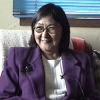
Rose Atuk Fosdick was interviewed on August 7, 2003 by Bill Schneider and Kumi Rattenbury at the Reindeer Herder's House in Nome, Alaska. Rose was director of Kawerak's Reindeer Herders Association and had a long-standing interest in documenting herding. Rose was chosen for an interview because she participated in some of the other interviews for this project, had reviewed the project, and had extensive experience with the herders and the issues that are important to them. Her interview came at the end of the project, so she was well-positioned to provide some general observations and to comment more specifically on the issues raised at the Reindeer Herders Association. In this interview, Rose talks about the evolution of the reindeer industry on the Seward Peninsula, reindeer management strategies, the effect of climate change on herding, and coordination between the Reindeer Herders Association and state and federal agencies.
Digital Asset Information
Project: Reindeer Herding: The Present and the Past
Date of Interview: Aug 7, 2003
Narrator(s): Rose Atuk Fosdick
Interviewer(s): Bill Schneider, Kumi Rattenbury
After clicking play, click on a section to navigate the audio or video clip.
Sections
1) Background information.
2) The evolution of issues regarding the reindeer industry and radio collars.
3) Managing reindeer.
4) Strategies for increasing reindeer population.
5) Climate changes effect herders.
6) Coordination of agencies and Reindeer Herders Associations' involvement.
Click play, then use Sections or Transcript to navigate the interview.
After clicking play, click a section of the transcript to navigate the audio or video clip.
Transcript
Section 1: parents and grandparents -- from Wales, Alaska/ 1946 -- parents moved to Nome/ skinboat/ Sinruk River/ older sister -- Alice/ Rose born -- Nome/ University of Alaska Fairbanks -- paper on Reindeer Herding/ BA degree -- Biology/ worked -- District Court/ Institute of Alaska Native Arts -- Services Director/ Nome -- Program Director for Reindeer Herders Association/ Vice President -- Natural Resources Division/ Land Management Services/ Fisheries/ Subsistence/ Eskimo Walrus Commission/ Reindeer Herders Association/ grandfather -- reindeer herder in Wales/ community herding/ grandfather -- Louis Tungwenuk/ born Russia/ raised -- Wales/ Clark M. Garber Collection/ reindeer skin parkas/ grandfather -- chief herder|
Section 2: 1990 -- issues/ predators/ loss to caribou/ market/ Western Arctic Caribou herd/ eastern edge of Seward Peninsula -- most effected/ University of Alaska Fairbanks Reindeer Research Program/ Natural Resource Conservation Service/ satellite and radio collars/ fall and spring time -- caribou enter Seward Peninsula/ helicopter or small plane -- locate reindeer with collars/ Fish and Game -- collar caribou/ communication/ Kobuk River/ Myrna/ caribou maps -- Fish and Game/ radio collar or flight observation/ helicopter -- herds reindeer away from the caribou/ predators -- increased problems/ grizzly bears/ wolves/ wolverine/ Reindeer Herders Association -- small/ predator control -- fund/ range issues -- boundaries/ Range Rules and Regulations/ separate herds -- ear tags|
Section 3: herders' perspective/ knowing where the animals are/ vegetation/ marking reindeer/ counting deer/ inoculations/ healthy range/ maintaining healthy herds/ veterinary health/ winter time -- ivermectin shot/ Brucellosis vaccination -- spring time/ Reindeer Research Program/ West Nile virus/ foot and mouth disease -- mad cow disease/ economics -- changes/ marketing -- reindeer antler/ Vancouver/ Seattle/ Los Angeles/ domestic US market/ Anchorage/ West Coast of US/ reindeer antler -- not highest demanded antler/ Sitka, Red, Elk/ RHA tallies/ 25,000 animals -- 1991/ 10,000 animals -- 2002/ Western side of Seward Peninsula/ history/ food/ unique to area|
Section 4: healthy herds/ protected/ corralled -- semi-tame/ assistance from Reindeer Herder Association/ St. Lawrence Island -- Savoonga/ animals tested -- Brucellosis/ seed population/ Safe Area Plans/ Natural Resource Conservation Service -- NRCS/ Reindeer Herders Association -- RHA/ mapped areas/ vegetation map -- Seward Peninsula/ winter feeding grounds/ agreement -- safe area/ cooperative management|
Section 5: snow fall changes/ RHA members/ caribou migration awareness/ no snow -- less access to range/ can't move animals/ good snow fall -- at least 6 inches/ Seward Peninsula -- differences in snow fall/ snow-machines/ Tom Gray's herd/ record tally/ role of RHA -- future/ advocates -- reindeer industry/ arrange meetings/ manage records/ encourage research/ land uses -- reindeer areas /Seward Peninsula/ islands -- south west Alaska/ coordination between agencies/ UAF Reindeer Research Program/ Natural Resource Conservation Service -- Soil Conservation Service/ learn about vegetation/ public land owners -- Alaska/ BLM -- National Park Service/ state and federal laws -- reindeer herders use land/ valid permits|
Section 6: coordinating efforts -- annual meeting/ March -- Nome/ range map/ impacts of reindeer by caribou/ historical photos/ ear tags/ tally sheets/ graph of population change/ next generation of herders/ reindeer -- valuable resource/ opportunity for employment/ Seward Peninsula/ herding heritage/ Nome|

